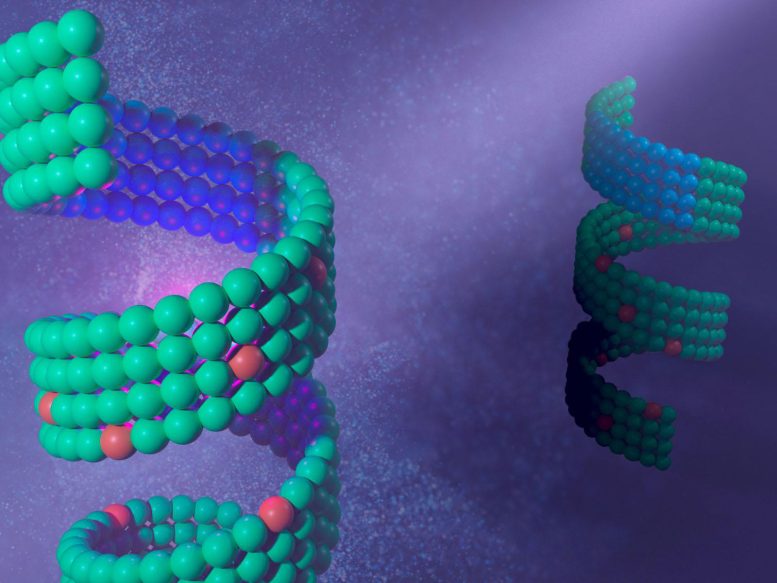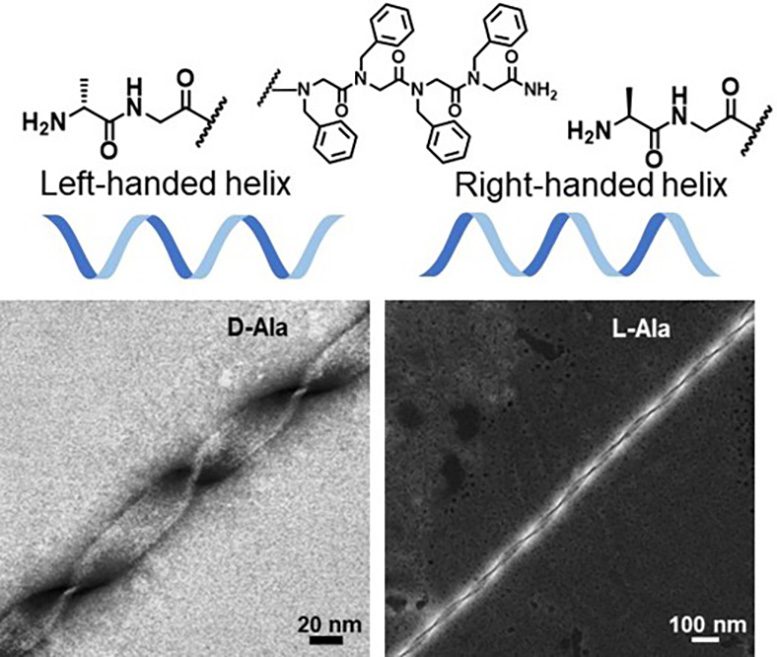
Scientists have created ways to manage the exact shapes and “handedness” of peptoids, which are like proteins and are important for things like delivering drugs and treating diseases. Their research shows their new methods for making practical peptoid-based materials for different uses in technology and medicine.
Researchers have figured out how to control the “handedness” of peptoids, which is important for accurate drug delivery and diagnostics.
Nature has very precise molecular shapes, like proteins that fit together perfectly and have different shapes that give them their function.
“Depending on their shape, proteins can fit together with other proteins to perform functions, or they can clump together and cause problems, like in Alzheimer’s disease,” explained materials scientist Chun-Long Chen. “Understanding how they fit together and why they have their particular shape could be important for things like delivering drugs, diagnostics, and treatments.”
In studies published in Nature Communications and Angewandte Chemie, Chen and his PNNL colleagues looked into how to control these shapes by making peptoid-based materials based on nature. He uses these advanced protein-like molecules to make substances for energy uses, such as capturing light or breaking down woody lignin. Over the last ten years, Chen and his team at Pacific Northwest National Laboratory have created a method for making special peptoid-based materials and studying how they behave.
“Peptoids could be used in lots of different ways,” said Chen. “Based on the shapes they form and their other features, it's possible to create peptoids that deliver drugs or act like man-made enzymes.”
Like a hand in a glove
Chen and his colleagues worked with the University of Washington, the University of Chicago, and the Georgia Institute of Technology to create peptoid assemblies with exact shapes. They were trying to control the “handedness” of the helix. Helices can be “left-handed” or “right-handed” depending on the way they spiral. Their results were published in Nature Communications.
“Handedness is really important when making special molecules, like drugs,” said Chen. “Understanding and controlling this handedness can help us understand processes like how proteins fit together and could be important for finding cures for diseases related to protein folding, like Alzheimer’s disease.”

Chun-Long Chen and his team found a way to control the shape of the peptoid helix. Credit: Chun-Long Chen | Pacific Northwest National Laboratory
For this experiment, Chen and his team chose to focus on corkscrew-like helical structures because they are important in biology. In fact, most proteins have these basic helical structures.
Previous methods of creating peptoids would result in a mixture of left- and right-handed helices. In nature, proteins need to be in a specific shape to carry out their functions—most of them being left-handed.
“Other groups before us were able to make peptoid nanohelices, but controlling their shapes and handedness precisely was a challenge,” said Chen. “Being able to control their shapes would not only allow for designing future materials, but also provide insights into biological processes involving these structures.”
By using a combination of experimental and computational methods, Chen and his team found a way to control the handedness of a peptoid helix. Similar to proteins, peptoids are made from amino acid-like building blocks. Every building block has the same “backbone” atoms that form peptoid bonds, however, each individual link in the chain can vary greatly. Chen’s group discovered that they could control the shape of the helix by changing the sequence of the peptoid side chains.
Adding another aspect to peptoid research
To further explore how peptoids can come together, Chen worked with colleagues from the University of Washington, Harvard University, Binghamton University, and Zhejiang Sci-Tech University. Building upon their previous two-dimensional studies of peptoid structures, the team managed to successfully create a three-dimensional helical nanostructure.
They found that by including special “functional groups” of atoms in their peptoid sequences, they could produce structures with special functions—similar to protein assemblies. Their research was published in Angewandte Chemie.
“Although this is a basic study, this research provides us with more understanding of how we can develop better, more accurate materials—similar to those found in nature—for specific uses,” said Chen. “Peptoids have the potential to be used in a variety of applications. Based on their structure and other characteristics, it’s possible to design peptoids as agents for delivering drugs or artificial light-harvesting systems.”
In the future, Chen and his team aim to create a wide range of nanomaterials based on peptoids for various applications. Controlling peptoid shape, as described in their research papers, is just the first step.
References: “Assembly of short amphiphilic peptoids into nanohelices with controllable supramolecular chirality” by Renyu Zheng, Mingfei Zhao, Jingshan S. Du, Tarunya Rao Sudarshan, Yicheng Zhou, Anant K. Paravastu, James J. De Yoreo, Andrew L. Ferguson and Chun-Long Chen, 16 April 2024, Nature Communications.
DOI: 10.1038/s41467-024-46839-y
“Hierarchical Self-Assembly of Multidimensional Functional Materials from Sequence-Defined Peptoids” by Li Shao, Dehong Hu, Shao-Liang Zheng, Thi Kim Hoang Trinh, Wenhao Zhou, Haoyu Wang, Yanxu Zong, Changning Li and Chun-Long Chen, 24 April 2024, Angewandte Chemie International Edition.
DOI: 10.1002/anie.202403263
Both studies were mainly funded by the Department of Energy, Office of Science, Basic Energy Sciences program as part of the Energy Frontier Research Centers program: CSSAS – The Center for the Science of Synthesis Across Scales.



